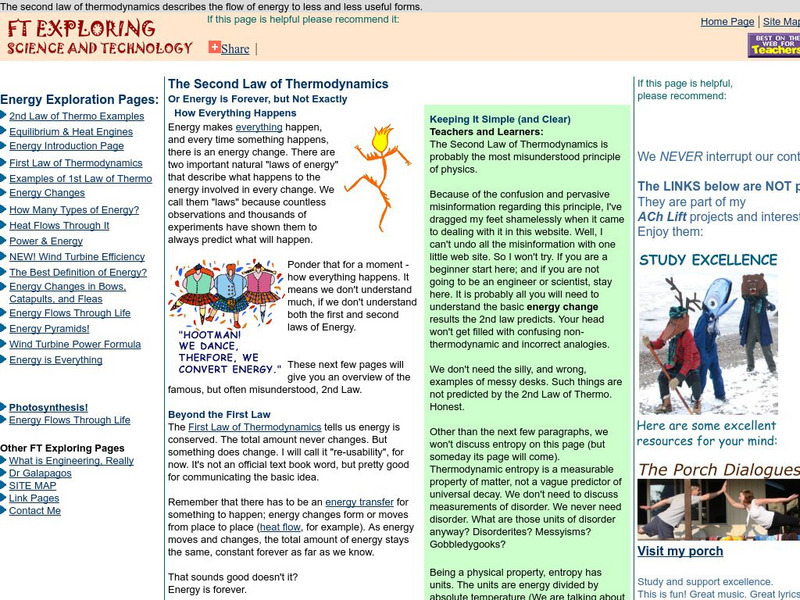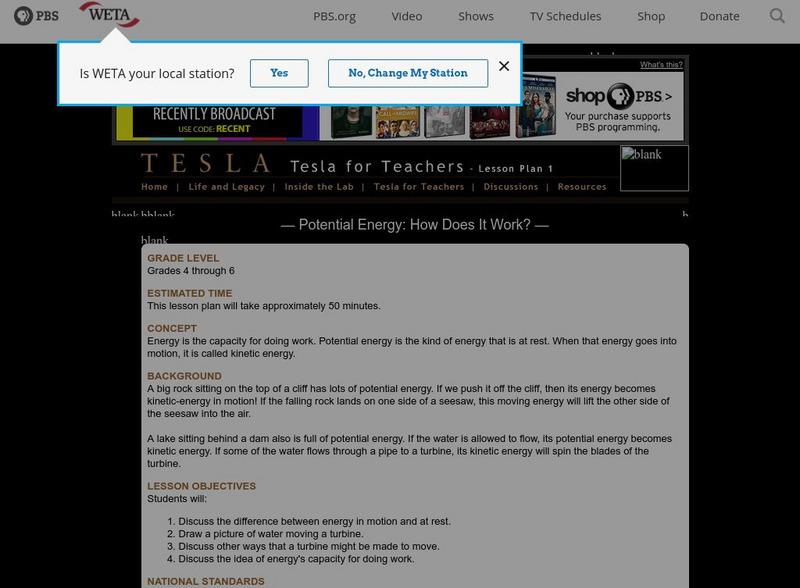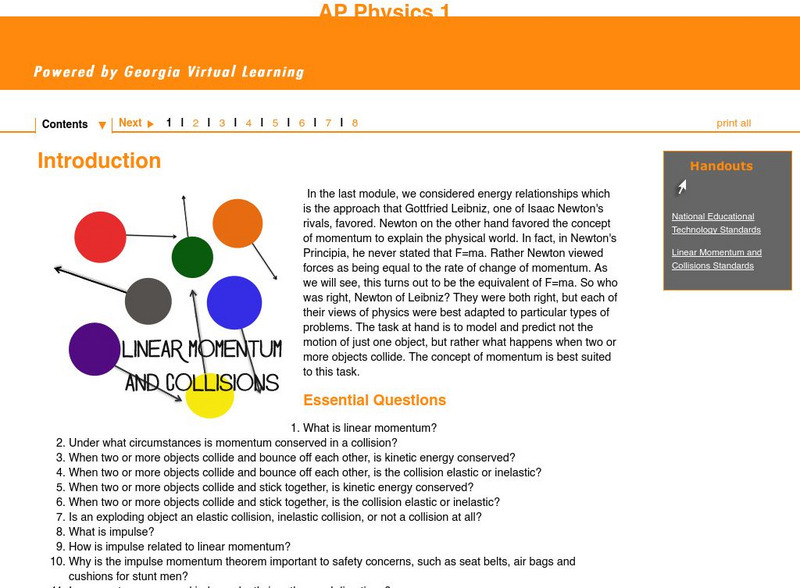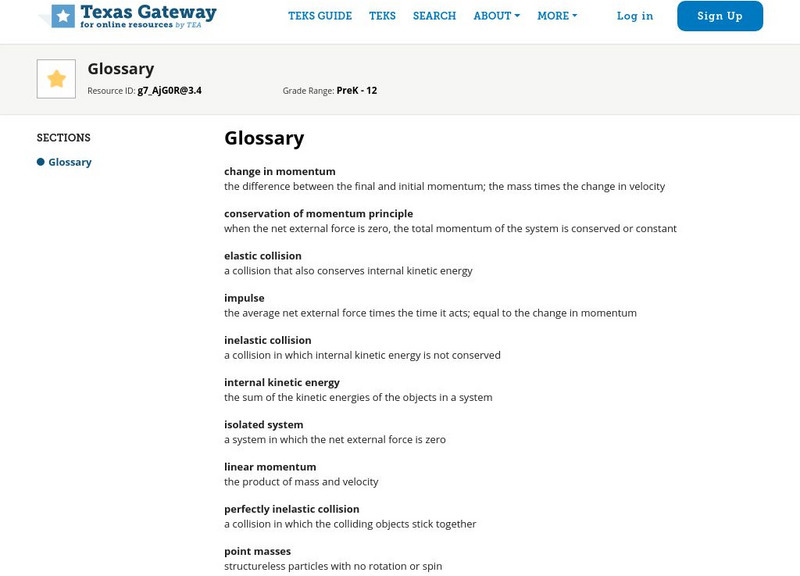Hi, what do you want to do?
Georgia Department of Education
Ga Virtual Learning: Ap Physics 1: Gravity
Combined with aspects of circular motion, students discover that Kepler's third law follows directly from the law of universal gravitation. This unit will expand upon the conservation of energy principle for problems beyond the confines...
Other
Laws of Thermodynamics
A page from the Fundamentals of Physical Geography site. Identifies, describes and elaborates upon the first, second, and third laws of thermodynamics.
NASA
Nasa: From Stargazers to Starships: Energy
Demonstrates how principles of kinetic energy, potential energy and energy conservation can be used to determine the speed of a descending object if given its initial height. Further discussion of other topics such as heat and...
Curated OER
Georgia State Univ.: Conservation of Energy
This site is from the Georgia State University Physics Department. At this site the conservation of energy as a fundamental conservation law is presented and compared to other conservation laws (momentum and angular momentum). Links to...
Curated OER
Georgia State Univ.: Conservation of Energy
This site is from the Georgia State University Physics Department. At this site the conservation of energy as a fundamental conservation law is presented and compared to other conservation laws (momentum and angular momentum). Links to...
Curated OER
Georgia State Univ.: Conservation of Energy
This site is from the Georgia State University Physics Department. At this site the conservation of energy as a fundamental conservation law is presented and compared to other conservation laws (momentum and angular momentum). Links to...
Curated OER
Georgia State Univ.: Conservation of Energy
This site is from the Georgia State University Physics Department. At this site the conservation of energy as a fundamental conservation law is presented and compared to other conservation laws (momentum and angular momentum). Links to...
Teachers TryScience
Teachers Try Science: Where There's Light, There's Hot Food!!!
This unit helps students learn to apply the concept of solar energy conservation. They are introduced to angles and their effect on the amount of light reflected, and they will also design, construct, manipulate, critique, evaluate and...
FT Exploring
Ft Exploring: The Second Law of Thermodynamics
Learn about one of the most misunderstood principles of physics, the second law of thermodynamics.
Annenberg Foundation
Annenberg Learner: Design a Roller Coaster
An interactive lesson where students design and build their own virtual roller coaster. Choose the height of the hills. the shape of the hills. and loop to find out if you successfully used physics concepts to pass the safety and fun...
Cosmo Learning
Cosmo Learning: Fundamentals of Physics
A collection of video lectures from a fundamentals of physics course taught at Yale University. The course is an introduction to physics and discusses Newtonian mechanics, special relativity, gravity, thermodynamics, and waves. Course...
E-learning for Kids
E Learning for Kids: Science: Mexican Diner: What Is Energy?
Meet Carlos at his Mexican diner, and he will tell all about energy and energy transformations.
PBS
Pbs Teachers: Potential Energy: How Does It Work?
Describe the difference between energy in motion and at rest, and demonstrate energy's capacity for doing work. Draw a picture of water moving a turbine, and discuss other ways that a turbine might be made to move.
Physics Aviary
Physics Aviary: Practice Problems: Energy on Incline Level 2
Students must predict the distance a box will move up an incline based on energy conservation. There will be friction present and some of the original KE will turn into heat.
Physics4kids
Rader's Physics4 kids.com: Thermodynamics & Heat: First Law of Thermodynamics
Explains how the first law of thermodynamics affects four types of thermodynamic systems.
Georgia Department of Education
Ga Virtual Learning: Ap Physics 1: Linear Momentum and Collisions
This physics tutorial aims to model and predict not the motion of just one object, but rather what happens when two or more objects collide. The concept of momentum will be the main focus of this module.
Khan Academy
Khan Academy: Gravitational Potential Energy at Large Distances Review
Review the equations and skills related to gravitational potential energy at large distances, including how to apply conservations laws to objects in orbit.
Famous Scientists
Famous Scientists: Hermann Von Helmholtz
Learn about the life and scientific discoveries of Hermann von Helmholtz in this article.
Alabama Learning Exchange
Alex: Actions at Plate Boundaries
This lesson will allow the students to understand the cause and effects of plates interactions. The students will learn that plate boundaries function as a release for much of the Earth's potential energy. The students will be able to...
Physics World
Physics World: Contextual Physics in Ocean Park
After downloading the "Motion Video Analysis" software, users can collect data about moving object's position from digital movie clips. This collection of data will allow them to plot motion graphs and draw conclusions about physics in...
Science Education Resource Center at Carleton College
Serc: Investigating Projectile Motion: Creating a Catapult
This lesson is for 9th grade physical science students. It begins with an inquiry-based lesson using a projectile motion computer simulation. It culminates with students building a catapult; applying and connecting science knowledge from...
Other
Fearof Physics: Videos
Looking for some more explanantion on a topic covered in physics class? This site contains videos that explore some physics concepts. Videos are broken down by topics. Some videos also give examples on how to solve problems.
Texas Education Agency
Texas Gateway: Linear Momentum and Collisions: Glossary
This is a glossary of the terms and definitions used in Chapter 8: Linear Momentum and Collisions from the AP Physics online text.
Other
Web Dictionary of Cybernetics:thermodynamics
A definition of thermodynamics and its laws from the Web Dictionary of Cybernetics and Systems. Part of an online dictionary of scientific terms. Includes hypertext links to other definitions are provided.






















